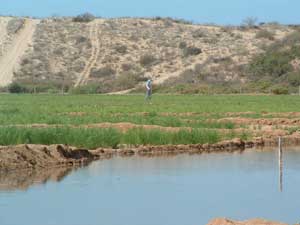U.S. organizations move toward nontraditional feedstocks

September 16, 2008
BY Ryan C. Christiansen
With soy oil prices on the rise, a number of U.S. organizations are moving toward nontraditional biodiesel feedstocks.
For example, Blue Sun Biodiesel in Golden, Colo., has received a $41,059 grant from the state to commercialize camelina as a biodiesel feedstock. The company said it will develop camelina production practices and publish a spring camelina production guide for farmers. Blue Sun is breeding spring and winter camelina to develop regionally adapted cultivars.
Meanwhile, 26 growers in eastern Oregon have planted camelina on marginal cropland to be harvested and taken to Williamette Biomass Processors Inc. in Rickreall, Ore. More than 1.5 million pounds of camelina seed will be crushed at the facility, said company Chief Executive Officer Craig Parker. The majority of the oil will be used by SeQuential-Pacific Biodiesel LLC in Salem, Ore., as a feedstock.
Lesquerella, another nonfood oilseed crop, is being considered for commercialization by Technology Crops International in Winston-Salem, N.C., while USDA-funded researchers are looking at the crop's potential use as a biodiesel feedstock. The mustard-family winter crop thrives in arid soil and brackish waters in the American Southwest, and is ideal for producing biodiesel for low-sulfur and ultra-low-sulfur petroleum diesel blends, according to the USDA. Lesquerella oil is rich in hydroxylated fatty acids, which contain molecules called estolides that naturally increase the lubricity of the oil, especially in cold temperatures.
A project proposing to use canola oil as a biodiesel feedstock in Snohomish County, Wash., has received funding from the USDA. The Sno/Sky Agriculture Alliance received $96,806 from the USDA to develop a canola seed storage facility in Monroe, Wash., and the Seattle-based Institute for Washington's Future received $28,650 to examine the feasibility of harvesting oilseed crops in the county. The goal of the project is to harvest 1,000 to 1,200 acres of canola annually, said Ryan Hembree, agricultural coordinator for the county.
Texas-based GreenGold Ray Energies Inc.'s jatropha plantations on Marinduque Island in the Philippines will be expanded to more than 24,700 acres, including areas on the Mindanao and Batan islands. The company plans to build up to four biodiesel plants, using jatropha as a feedstock, according to investor relations spokesman Har Deep.
At farms in Bahia Kino and Tastiota, Mexico, Phoenix-based Global Seawater Inc. is using coastal land and seawater to grow salicornia, a salt-loving halophyte plant that thrives in heat and poor soil. Also known as sea asparagus, salicornia has traditionally been a food source, but Global Seawater is considering it as a biodiesel feedstock, said company spokesman Jason McCoy. The company is raising capital to create a 5,000-hectare (12,355-acre) commercial salicornia farm.
Other companies are moving away from plant-based oil sources altogether. Natural Innovative Renewable Energy in Breda, Iowa, plans to build a 60 MMgy biodiesel plant in South Sioux City, Neb., according to company spokesman Jim Venner. The company plans to begin producing biodiesel using beef tallow provided by Beef Products Inc., a local meat processor.
For example, Blue Sun Biodiesel in Golden, Colo., has received a $41,059 grant from the state to commercialize camelina as a biodiesel feedstock. The company said it will develop camelina production practices and publish a spring camelina production guide for farmers. Blue Sun is breeding spring and winter camelina to develop regionally adapted cultivars.
Meanwhile, 26 growers in eastern Oregon have planted camelina on marginal cropland to be harvested and taken to Williamette Biomass Processors Inc. in Rickreall, Ore. More than 1.5 million pounds of camelina seed will be crushed at the facility, said company Chief Executive Officer Craig Parker. The majority of the oil will be used by SeQuential-Pacific Biodiesel LLC in Salem, Ore., as a feedstock.
Lesquerella, another nonfood oilseed crop, is being considered for commercialization by Technology Crops International in Winston-Salem, N.C., while USDA-funded researchers are looking at the crop's potential use as a biodiesel feedstock. The mustard-family winter crop thrives in arid soil and brackish waters in the American Southwest, and is ideal for producing biodiesel for low-sulfur and ultra-low-sulfur petroleum diesel blends, according to the USDA. Lesquerella oil is rich in hydroxylated fatty acids, which contain molecules called estolides that naturally increase the lubricity of the oil, especially in cold temperatures.
A project proposing to use canola oil as a biodiesel feedstock in Snohomish County, Wash., has received funding from the USDA. The Sno/Sky Agriculture Alliance received $96,806 from the USDA to develop a canola seed storage facility in Monroe, Wash., and the Seattle-based Institute for Washington's Future received $28,650 to examine the feasibility of harvesting oilseed crops in the county. The goal of the project is to harvest 1,000 to 1,200 acres of canola annually, said Ryan Hembree, agricultural coordinator for the county.
Texas-based GreenGold Ray Energies Inc.'s jatropha plantations on Marinduque Island in the Philippines will be expanded to more than 24,700 acres, including areas on the Mindanao and Batan islands. The company plans to build up to four biodiesel plants, using jatropha as a feedstock, according to investor relations spokesman Har Deep.
At farms in Bahia Kino and Tastiota, Mexico, Phoenix-based Global Seawater Inc. is using coastal land and seawater to grow salicornia, a salt-loving halophyte plant that thrives in heat and poor soil. Also known as sea asparagus, salicornia has traditionally been a food source, but Global Seawater is considering it as a biodiesel feedstock, said company spokesman Jason McCoy. The company is raising capital to create a 5,000-hectare (12,355-acre) commercial salicornia farm.
Other companies are moving away from plant-based oil sources altogether. Natural Innovative Renewable Energy in Breda, Iowa, plans to build a 60 MMgy biodiesel plant in South Sioux City, Neb., according to company spokesman Jim Venner. The company plans to begin producing biodiesel using beef tallow provided by Beef Products Inc., a local meat processor.
Advertisement
Advertisement
Upcoming Events





